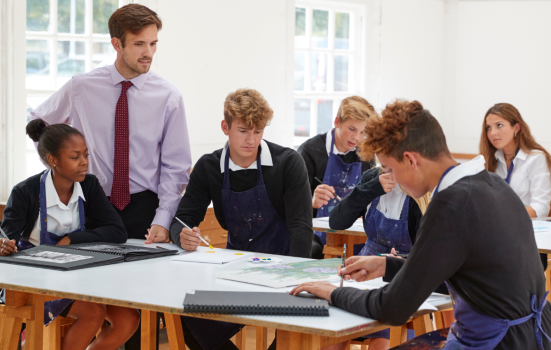The total number of exam entries to all creative arts subjects falls by 4% compared with last year, representing its smallest ever share of total GCSE exam entries.

monkeybusinessimages via iStock
Enrolment in arts subjects at GCSE level has fallen to a new low, according to analysis of exam entries this summer.
The total number of exam entries across seven creative arts subjects – art and design, dance, design and technology, drama, media, film and tv studies, music, and performing and expressive arts – stood at 420,811 this summer, a 4% decrease when compared with 2022.
This figure represents 7.1% of all GCSE exam entries – the lowest share of total exam entries ever for creative arts subjects. Across all subjects, GCSE exam entries were up 3%.
READ MORE:
The findings follow a trend of this year’s A-level exam entries, which saw creative arts subjects make up their smallest ever share of total exam entries.
At GCSE level, the largest year-on-year decreases among arts subjects were seen in performing and expressive arts (17% fewer entries), dance (16%) and music (13%).
Drama entries were down 7% this summer, while art and design entries were down 4%. Only design and technology and media, film and tv studies experienced a year-on-year increase, of 1% and 5% respectively.
Analysis of arts subject entries has been completed by Campaign for the Arts. The alliance’s director, Jack Gamble, told Arts Professional there is a need for urgent action to address a decade of decline.
“The arts are being sidelined in England’s state schools, and the knock-on effects at both GCSE and A-level are already plain to see. The impacts on our culture and our creative industries may be more gradual, but they will be long-lasting,” Gamble said.
“It’s time to review the exclusion of arts subjects from the English Baccalaureate (EBacc) and the widening inequality of arts opportunities between state and private schools.”
“Arts education matters, and the experiences and careers it opens up should be available to all children, whatever school they go to and whatever their background.”
Continued decline
The number of combined entries to all arts subjects has fallen by 42% since 2010, the year the EBacc was introduced.
Since 2010, design and technology has seen the largest fall in entries (70%), followed by performing and expressive arts (69%) and dance (56%).
Susan M Coles, artist and Secretary to the All-Party Parliamentary Group (APPG) for Art, Craft and Design in Education, says the reductions in arts provision in schools since 2010 has already damaged the talent pipeline.
“[This] is already affecting sectors such as visual arts, design, advertising, film, and more. This will impact economic growth, job creation, and the country's overall competitiveness in the global creative market,” Coles said.
Coles added fewer students taking GCSE art will lead to a smaller pool of individuals interested and qualified to pursue A-level art courses.
“This will lead to reduced class sizes and fewer A-level art options offered by schools and colleges. Less students leads to budget, staff, and curriculum cuts across the board,” she explained.
Staffing concerns
Declining exam entries in creative subjects at both GCSE and A-level is happening against a backdrop of fewer teachers.
Analysis conducted by the National Foundation for Education Research earlier this year found recruitment of teachers in design and technology, music, drama and art and design is set to be more than 20% below target for the 2023/24 academic year.
An inquiry commissioned by the APPG for Art, Craft and Design in Education, has called for a focus on recruiting and retaining teachers in creative subjects.
“Currently we are not recruiting enough teachers to teach our subject. There is no bursary for trainee art teachers, the subject is undervalued by policymakers/government which discourages some potential teachers from pursuing a career in art education,” Coles added.
“This shortage also leads to non-specialist teaching of the subject in Key Stage 3, which also impacts on GCSE choices.”
“A decrease in the number of students exposed to art education will lead to a future potential decline in audience appreciation and engagement with artistic and cultural content.”




